Weaver Wednesday [85]: Fan-tailed Widowbird 2014-01-29 (478)
 Weaver Wednesday
Weaver Wednesday
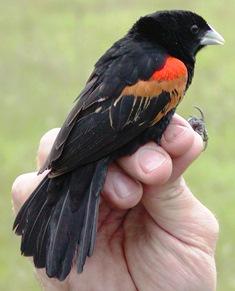
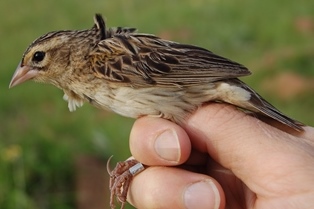
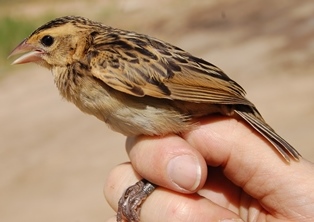
The Fan-tailed Widowbird Euplectes axillaris breeding male is black with a pale blue-grey bill, orange-red and cinnamon shoulder patch. The broad fan-shaped tail is much shorter than that of the Hartlaub's Widowbird F. hartlaubi. The non-breeding male is dull with heavy streaking above, a dark crown, conspicuous pale supercilium, red shoulder patches, and black primaries. The female is similar but has brown primaries, and duller shoulder. All ages and sexes have a distinguishing cinnamon underwing.
Five subspecies of the Fan-tailed Widowbird are recognised (see map below, based on Handbook of the Birds of the World, Vol. 15:
E. a. axillaris in the lowlands of Malawi, through Mozambique, to eastern South Africa (red on map).
E. a. bocagei in West Africa from Mali south to Angola, Zambia, Caprivi area in Namibia, Okavango swamps in Botswana and NW Zimbabwe (dark blue on map). This race has a large bill, and the breeding male has orange-yellow shoulder patches above cinnamon coverts, making a broader epaulet than in other subspecies.
E. a. phoeniceus in South Sudan through East Africa to NE Zambia and Malawi (green on map). The breeding male has orange (not red) lesser coverts.
E. a. traversii in the Ethiopian highlands (light blue on map). This race is similar to phoeniceus but the breeding male has a proportionately longer tail, and the alula is usually cinnamon-brown.
E. a. zanzibaricus along the coast from Somalia to Tanzania including Zanzibar and Pemba (yellow on map). This race is also similar to phoeniceus but the breeding male has a heavy bill and dark spots on the cinnamon wing-coverts.
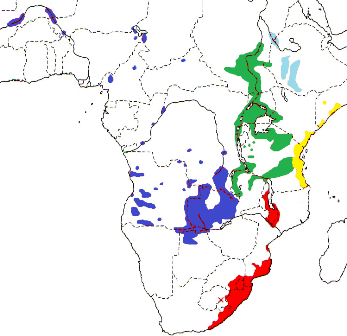
The Fan-tailed Widowbird inhabits tall moist grassland and swamp edges, but at the coast also occurs in dry savanna and cultivation including sugarcane fields. It is gregarious, forming large post-breeding flocks. It roosts and feeds with other weavers. Ringed adults in South Africa have survived for longer than 9 years (see weaver longevities).
The Fan-tailed Widowbird feeds on seeds of grasses, herbs and rice; and also eats insects, including termites and caterpillars.
The Fan-tailed Widowbird is polygynous and territorial. A male owns up to 8 nests in his territory. The male flies over his territory in a slow, undulating flight, just above the vegetation, then suddently alights on a tall grass stem. The male sings from a prominent perch, with epaulets conspicuous, and tail spread. If a female lands in his territory, themale displays with wings arched and spread, bouncing up and down in front of thefemale, and singing loudly. The male also sings at his nest frame, swaying from side to side. The epaulet colour is important in male-male interactions, while tail length is important in attracting females.
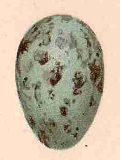
The nest is an oval ball of thin woven grass strips, with a dense lining of seedheads projecting from the entrance. The nest is attached to 2 or more stems of grass or other plants. The male builds the frame, weaving long grass strands into the bower of living grass. The female packs lining of up to 540 grass seedheads in the nest.
The clutch is 2-3 eggs which are pale blue-green, irregularly marked with large olive or brown markings. Incubation is by the female only, as is feeding of the chicks.
There are no PHOWN records for the Fan-tailed Widowbird yet, but there are 7 egg records from Angola (see PHOWN summary). Submit any weaver nest records to PHOWN (PHOtos of Weaver Nests) via the Virtual Museum upload site.
PHOWN summary
Previous Wedn: Black-throated Weaver
Full weaver species list
|


 Weaver Watch
Weaver Watch


